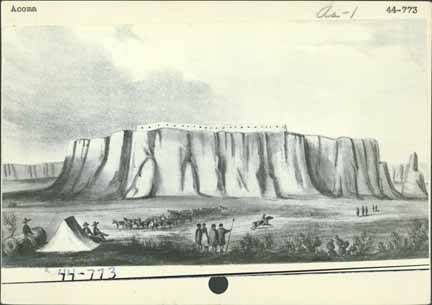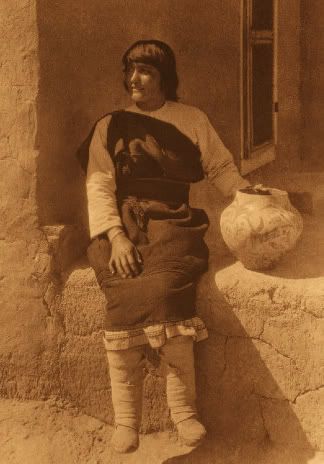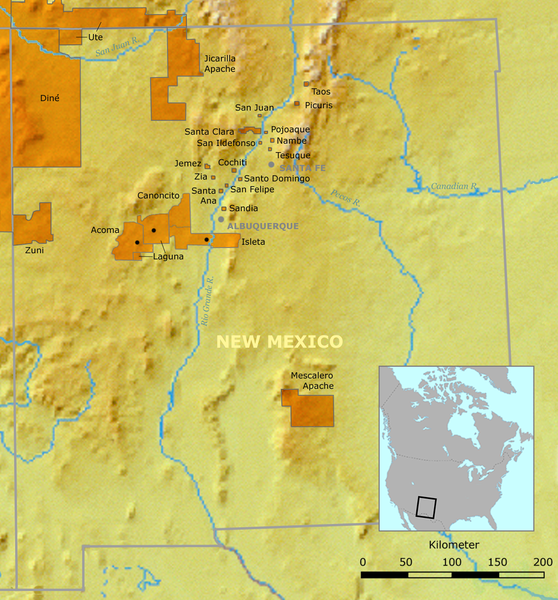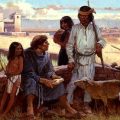When the Spanish first began to explore the area which would later be known as New Mexico, they encountered well-established Indian agricultural villages. Collectively, the Spanish referred to these people as Pueblos (Spanish for village). While the Pueblos share some common features of material culture, such as the architecture of their permanent villages, they are culturally distinct from one another. In New Mexico, the various Pueblo languages belong to three different language families: Keresan, Tanoan, and Zunian.
Linguistically, the Keresan language family is divided into two groups: Eastern, which includes Cochiti, San Felipe, Santa Ana, Santo Domingo, and Zia; and Western, which includes Laguna and Acoma. Some researchers, such as Alfonso Ortiz, feel that there is a linguistic connection between Keresan and the languages of the Caribbean.
Santa Ana:
Often ignoring the cultural distinctions of the different Pueblos, the Spanish often renamed the Indian villages in honor of Catholic saints. Thus the Keresan-speaking Tamaya were given the name Santa Ana (St. Ann) by the Spanish in 1598.
According to the oral tradition of the people of Santa Ana (Tamaya), the people first emerged from the underworld at a place north and west of their present location. When they came into this world, they would travel over the earth to find the place that would suit them the best. Here they would make their homes. The people traveled for a long time and passed through many fine lands. They paused when they were hungry to gather the nourishment which the earth provided for them. Then they would continue their journey.
The Tamaya first settled at a place called Kashe K’atreti (White House). It was here that they set up a larger system of government. Here they established the foundations of their way of life in the upper world. This was not, however, their final destination, and so they moved, traveling south and east. They reached the eastern slope of the Sandía Mountains and established the village of Paak’u in a high valley west of the San Pedro Arroyo. They lived in Paak’u for more than a century.
When the people reached Paak’u, they divided into two groups. One of these groups traveled through the Río Grande Valley where they established a small village near the present-day San Felipe Pueblo. They were there only a short time before they journeyed north and west where they settled near the present-day pueblo of Zia. They left this village and traveled west and built another village near the present-day pueblo of Jemez. After the Navajo arrived in the region, the people were forced to flee this village and moved to the top of a mesa. Eventually they journeyed again, settling for a while near Acoma Pueblo. Then they built a village near the modern town of Socorro.
They eventually returned to rejoin the people of Paak’u and then established a series of small farming villages along the Río Grande River. Their journey, however, was not over. From here they traveled north, and, after centuries of travel, their journey ended. Beside the river and beneath a broad mesa, the people found the land which was just right for them, in accordance with the instructions given to their ancestors. Here was their home.
Acoma:
Acoma Pueblo takes its name from the Keresan term Akome which means “people of the white rock.”

Shown above is an Ansel Adams photograph of Acoma.

Shown above is an 1846 drawing of Acoma.
The oral tradition of Acoma tells that the people came out from the underworld at a place to the north. At this place there was a lake with an island and on this island there was a house. It was here that the katsinas came and brought many gifts to the people. They taught the people how to use these gifts. The katsinas danced in the plaza and the people were happy. After a time, the people decided that it was time for them to leave this place: the place was so precious that they feared they might defile it. They travelled south to a place called Kacikatcuria (White House). Here they called the katsinas to dance for them and they prepared the prayersticks and made the proper offerings.
One evening, after the katsinas had danced for them and then left, one man did a comic imitation of the katsina dances. He exaggerated the movements and this comic imitation caused great merriment among the people. However, one katsina had remained behind and witnessed the parody. As a result, the katsinas made war against the village. After the battle, only a few people were left alive and they were told that they would never see the katsinas again. They were told that if they wanted the katsinas to come to their village, then they must dress like the katsinas and pray was they had been taught. There was, however, conflict over whether or not it was appropriate to impersonate the katsinas and this caused some groups to migrate to new locations and to speak different languages.
One group of people decided to go to the south where they will be able to raise parrots. They were looking for a place called Aako. They would know this place because there would be a good echo. Just to the east of present-day Acoma, they found Aako. Here the people once again divided, with some continuing south and others staying to establish the pueblo of Acoma. Here they impersonated the katsinas and danced in the plaza. Their prayers for rain were answered and the people knew that the ceremony was powerful.
Cochiti:
Cochiti oral tradition tells that the origin of the people on the earth began with their emergence from the underground through the sipapu. They began their life on earth living at White House, located far to the north. Here they lived with all of the people of the world. They then began a series of journeys or travels during which time they encountered a number of spiritual beings, animal helpers, and culture heroes. At one time, in the more recent past, they lived at Fijoles Cañon along with some other Pueblo groups.
http://www.pueblodecochiti.org/

Shown above is a photo of a Cochiti woman by Edward Curtis.
Pueblo Migrations:
The various culturally distinct Pueblos have lived and farmed in New Mexico and Arizona for thousands of years. Their villages made of stone and adobe brick amazed the first Europeans who visited them and continue to impress today’s tourists. Still, the oral histories of the Pueblos and the archaeological record show that the people made many migrations prior to settling in their current locations. This essay has looked at only three of the Keresan-speaking Pueblos. The oral traditions of the other Pueblos, including the Uto-Aztecan-speaking Hopi and the Tanoan-speaking Pueblos, also tell of migrations.
Some archaeologists and tribal oral historians feel that the references to “White House” in the Kersesan stories may refer to the great houses (large multi-story complexes) of Chaco Canyon.



Leave a Reply